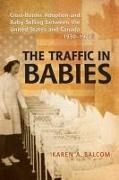Read more
Informationen zum Autor Karen A. Balcom is an associate professor in the Department of History at McMaster University. Klappentext Between 1930 and the mid-1970s, several thousand Canadian-born children were adopted by families in the United States. At times, adopting across the border was a strategy used to deliberately avoid professional oversight and take advantage of varying levels of regulation across states and provinces. The Traffic in Babies traces the efforts of Canadian and American child welfare leaders—with intermittent support from immigration officials, politicians, police, and criminal prosecutors—to build bridges between disconnected jurisdictions and control the flow of babies across the Canada-U.S. border.Karen A. Balcom details the dramatic and sometimes tragic history of cross-border adoptions—from the Ideal Maternity Home case and the Alberta Babies-for-Export scandal to trans-racial adoptions of Aboriginal children. Exploring how and why babies were moved across borders, The Traffic in Babies is a fascinating look at how social workers and other policy makers tried to find the birth mothers, adopted children, and adoptive parents who disappeared into the spaces between child welfare and immigration laws in Canada and the United States. Zusammenfassung Exploring how and why babies were moved across borders! The Traffic in Babies is a fascinating look at how social workers and other policy makers tried to find birth mothers! adopted children! and adoptive parents. Inhaltsverzeichnis Contents Preface and Acknowledgements Introduction: Babies Across Borders Charlotte Whitton and Border-Crossings in the 1930s Border-Crossing Responses to the Ideal Maternity Home, 1945-1947 The Alberta Babies-for-Export Scandal, 1947-1949 Cross-Border Placements for Catholic Children From Quebec, 1945-1960 Criminal Law and Baby Black Markets, 1954-1964 Controlling Cross Border Adoption, 1950-1972 Conclusion: A "No Man's Land" of Jurisdiction Bibliography...

